Research Report: Applications of Star Polymers in Drug Delivery
VerifiedAdded on 2023/01/04
|14
|3225
|61
Report
AI Summary
This report provides a comprehensive overview of star polymers, a significant area of polymer science. It details the unique characteristics of star polymers, including their structure (multiple linear chains attached to a central core), mechanical, rheological, and biomedical properties, which distinguish them from other polymeric materials. The report discusses the synthesis of star polymers using techniques like reversible addition fragmentation chain-transfer polymerization. A key focus is on the application of star polymers in drug delivery, emphasizing their biocompatibility, ability to conjugate with drugs, and potential for controlled release in cancer treatment. The report also compares star polymers to other drug delivery methods like microneedles and highlights the advantages of star polymers due to their compact structure, larger surface area, and unique rheological properties. Various aspects such as amphiphilic star-shaped polymers, their core structure, and drug encapsulation are also discussed. The report also includes the advantages of star polymers over microneedles and linear polymers.

Running head: POLYMER RESEARCH 1
Star polymers
Name
Institution
Star polymers
Name
Institution
Paraphrase This Document
Need a fresh take? Get an instant paraphrase of this document with our AI Paraphraser

POLYMER RESEARCH 2
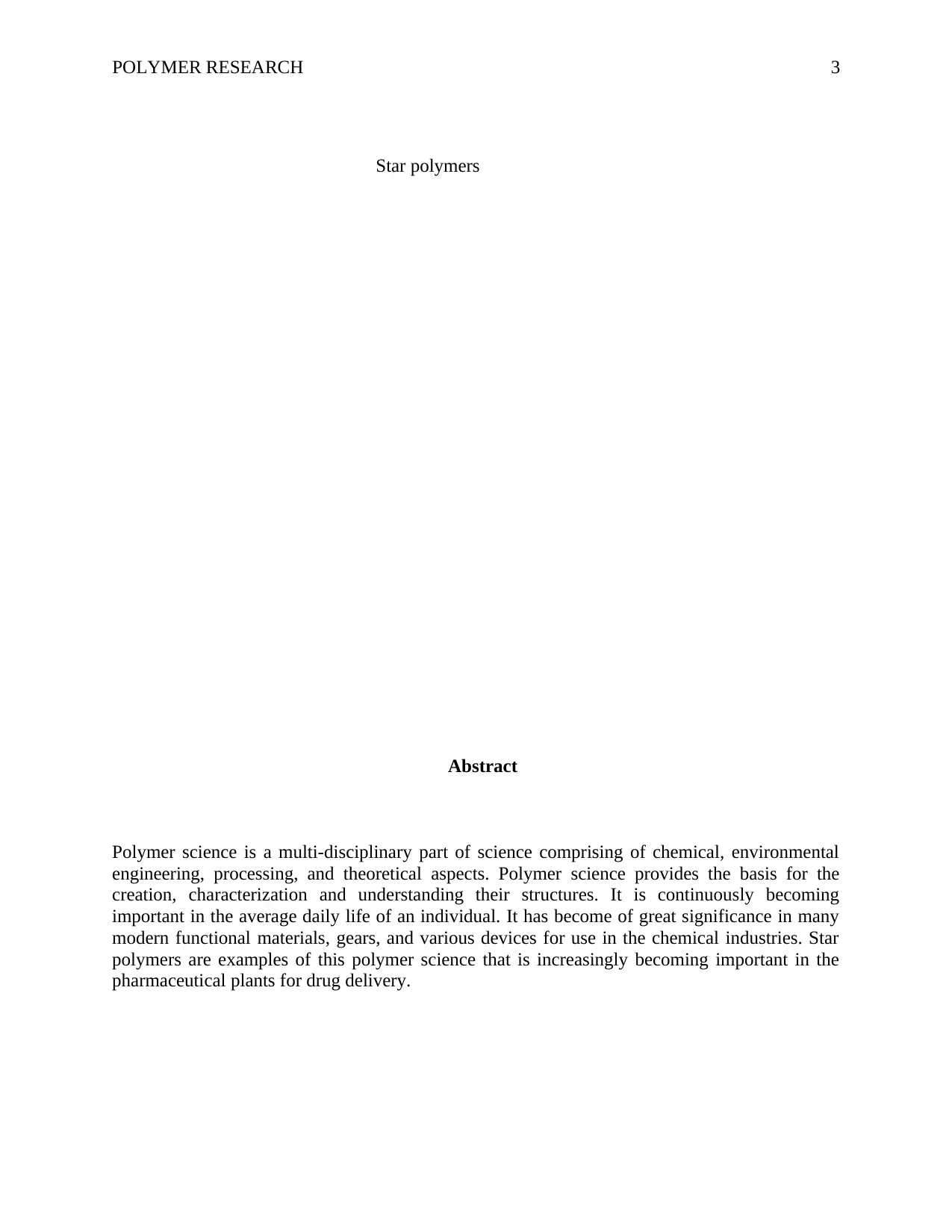
POLYMER RESEARCH 3
Star polymers
Abstract
Polymer science is a multi-disciplinary part of science comprising of chemical, environmental
engineering, processing, and theoretical aspects. Polymer science provides the basis for the
creation, characterization and understanding their structures. It is continuously becoming
important in the average daily life of an individual. It has become of great significance in many
modern functional materials, gears, and various devices for use in the chemical industries. Star
polymers are examples of this polymer science that is increasingly becoming important in the
pharmaceutical plants for drug delivery.
Star polymers
Abstract
Polymer science is a multi-disciplinary part of science comprising of chemical, environmental
engineering, processing, and theoretical aspects. Polymer science provides the basis for the
creation, characterization and understanding their structures. It is continuously becoming
important in the average daily life of an individual. It has become of great significance in many
modern functional materials, gears, and various devices for use in the chemical industries. Star
polymers are examples of this polymer science that is increasingly becoming important in the
pharmaceutical plants for drug delivery.
⊘ This is a preview!⊘
Do you want full access?
Subscribe today to unlock all pages.

Trusted by 1+ million students worldwide

POLYMER RESEARCH 4
Introduction
The recent development in polymer science has made advances in controlled
polymerization techniques and efficient of coupling chemistries that have facilitated the
production and synthesis of very complex polymers with controlled functionalities. Star polymer
is one of the recent development in polymer science (Wu, Wang, & Li, 2015). It is made by fusing
of several linear polymers into a central point with a more significant number of chain end
functionalities.
Star polymers generally exhibit excellent characteristics and properties making them a
unique category of technology significant nanomaterial. These unique properties make star
polymers be used for many applications in the real-life situation (Wu, Wang, & Li, 2015). This
report provides a comprehensive summary on the various application of star polymers, the
multiple stages of development and commercialization of the polymer as well as the distinctive
properties that make then best suited for this application altogether.
Results and Discussion
The polymer science associated with star polymer and the possible application or
applications being pursued. Star polymers are made up of several linear chains attached to a
central core. They are sub-classified into in terms of branches depending on the nature of the
various branches. When the branches are identical, it is referred to as symmetric stars and
asymmetric in the case where the branches are different. Moreover, when the branches are
chemically different, then they are termed as ‘miktoarm’ stars (Wu, Wang, & Li, 2015). Star
polymers have unique mechanical, rheological, as well as biomedical properties that make them
unique from other polymeric materials.
Introduction
The recent development in polymer science has made advances in controlled
polymerization techniques and efficient of coupling chemistries that have facilitated the
production and synthesis of very complex polymers with controlled functionalities. Star polymer
is one of the recent development in polymer science (Wu, Wang, & Li, 2015). It is made by fusing
of several linear polymers into a central point with a more significant number of chain end
functionalities.
Star polymers generally exhibit excellent characteristics and properties making them a
unique category of technology significant nanomaterial. These unique properties make star
polymers be used for many applications in the real-life situation (Wu, Wang, & Li, 2015). This
report provides a comprehensive summary on the various application of star polymers, the
multiple stages of development and commercialization of the polymer as well as the distinctive
properties that make then best suited for this application altogether.
Results and Discussion
The polymer science associated with star polymer and the possible application or
applications being pursued. Star polymers are made up of several linear chains attached to a
central core. They are sub-classified into in terms of branches depending on the nature of the
various branches. When the branches are identical, it is referred to as symmetric stars and
asymmetric in the case where the branches are different. Moreover, when the branches are
chemically different, then they are termed as ‘miktoarm’ stars (Wu, Wang, & Li, 2015). Star
polymers have unique mechanical, rheological, as well as biomedical properties that make them
unique from other polymeric materials.
Paraphrase This Document
Need a fresh take? Get an instant paraphrase of this document with our AI Paraphraser
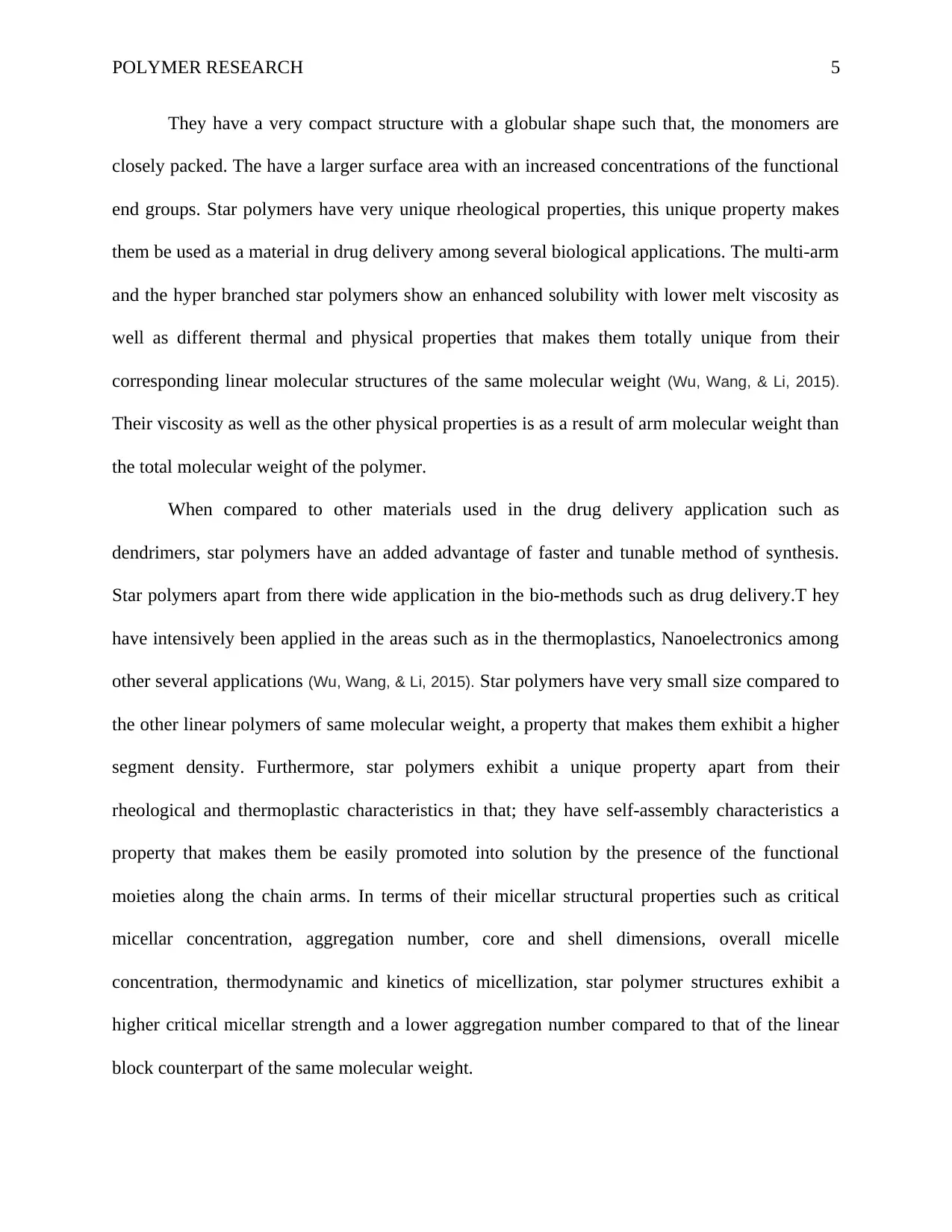
POLYMER RESEARCH 5
They have a very compact structure with a globular shape such that, the monomers are
closely packed. The have a larger surface area with an increased concentrations of the functional
end groups. Star polymers have very unique rheological properties, this unique property makes
them be used as a material in drug delivery among several biological applications. The multi-arm
and the hyper branched star polymers show an enhanced solubility with lower melt viscosity as
well as different thermal and physical properties that makes them totally unique from their
corresponding linear molecular structures of the same molecular weight (Wu, Wang, & Li, 2015).
Their viscosity as well as the other physical properties is as a result of arm molecular weight than
the total molecular weight of the polymer.
When compared to other materials used in the drug delivery application such as
dendrimers, star polymers have an added advantage of faster and tunable method of synthesis.
Star polymers apart from there wide application in the bio-methods such as drug delivery.T hey
have intensively been applied in the areas such as in the thermoplastics, Nanoelectronics among
other several applications (Wu, Wang, & Li, 2015). Star polymers have very small size compared to
the other linear polymers of same molecular weight, a property that makes them exhibit a higher
segment density. Furthermore, star polymers exhibit a unique property apart from their
rheological and thermoplastic characteristics in that; they have self-assembly characteristics a
property that makes them be easily promoted into solution by the presence of the functional
moieties along the chain arms. In terms of their micellar structural properties such as critical
micellar concentration, aggregation number, core and shell dimensions, overall micelle
concentration, thermodynamic and kinetics of micellization, star polymer structures exhibit a
higher critical micellar strength and a lower aggregation number compared to that of the linear
block counterpart of the same molecular weight.
They have a very compact structure with a globular shape such that, the monomers are
closely packed. The have a larger surface area with an increased concentrations of the functional
end groups. Star polymers have very unique rheological properties, this unique property makes
them be used as a material in drug delivery among several biological applications. The multi-arm
and the hyper branched star polymers show an enhanced solubility with lower melt viscosity as
well as different thermal and physical properties that makes them totally unique from their
corresponding linear molecular structures of the same molecular weight (Wu, Wang, & Li, 2015).
Their viscosity as well as the other physical properties is as a result of arm molecular weight than
the total molecular weight of the polymer.
When compared to other materials used in the drug delivery application such as
dendrimers, star polymers have an added advantage of faster and tunable method of synthesis.
Star polymers apart from there wide application in the bio-methods such as drug delivery.T hey
have intensively been applied in the areas such as in the thermoplastics, Nanoelectronics among
other several applications (Wu, Wang, & Li, 2015). Star polymers have very small size compared to
the other linear polymers of same molecular weight, a property that makes them exhibit a higher
segment density. Furthermore, star polymers exhibit a unique property apart from their
rheological and thermoplastic characteristics in that; they have self-assembly characteristics a
property that makes them be easily promoted into solution by the presence of the functional
moieties along the chain arms. In terms of their micellar structural properties such as critical
micellar concentration, aggregation number, core and shell dimensions, overall micelle
concentration, thermodynamic and kinetics of micellization, star polymer structures exhibit a
higher critical micellar strength and a lower aggregation number compared to that of the linear
block counterpart of the same molecular weight.

POLYMER RESEARCH 6
Their micellar properties are greatly affected by the pH of the aqueous solution in that, at
a high pH value, star polymer significantly dissolves acquiring an extended conformation.
However, at a low pH, they show a low degree of neutralization as well as the formation of
larger spherical micelles. Amphiphilic tar polymer with their drug encapsulation properties
can be used in the encapsulation of hydrophobic drugs in micelles of star polymers into aqueous
vivo environment. Star polymer can functionalize its functional groups a property that suits its
application in the drug delivery as drugs can achieve more targeted deliveries for the drug to be
imaged (Wu, Wang, & Li, 2015). This is more useful in the cancer treatment whereby attaching a
ligand that easily recognizes the cancer cells hence increasing the efficacy of the drug delivery
systems.
Star polymers can generally be synthesis by using arm first, arm in or use of the convent
approach. The synthesized macromolecular chains react with the multifunctional linking agent to
forming a star-shaped polymer. There are several techniques used for the synthesis of star
polymer such as; atom transfer radical polymerization, use of reversible addition fragmentation-
chain transfer polymerization, the application of nitroxide-mediated free-radical polymerization
technique, the use of ring opening polymerization (Wu, Wang, & Li, 2015). However, in this report
reversible addition fragmentation chain-transfer was used, where chain –transfer agents
containing thiocarbonnylthio moieties are degenerately transferred. This is the most versatile
technique used in the synthesis of star shape polymer as it can be able to tolerate myriad reaction
conditions. The scheme below reproduced from (DIO: 10 .1021/ma02119) show how the
technique can be employed in the synthesis of star polymers.
Their micellar properties are greatly affected by the pH of the aqueous solution in that, at
a high pH value, star polymer significantly dissolves acquiring an extended conformation.
However, at a low pH, they show a low degree of neutralization as well as the formation of
larger spherical micelles. Amphiphilic tar polymer with their drug encapsulation properties
can be used in the encapsulation of hydrophobic drugs in micelles of star polymers into aqueous
vivo environment. Star polymer can functionalize its functional groups a property that suits its
application in the drug delivery as drugs can achieve more targeted deliveries for the drug to be
imaged (Wu, Wang, & Li, 2015). This is more useful in the cancer treatment whereby attaching a
ligand that easily recognizes the cancer cells hence increasing the efficacy of the drug delivery
systems.
Star polymers can generally be synthesis by using arm first, arm in or use of the convent
approach. The synthesized macromolecular chains react with the multifunctional linking agent to
forming a star-shaped polymer. There are several techniques used for the synthesis of star
polymer such as; atom transfer radical polymerization, use of reversible addition fragmentation-
chain transfer polymerization, the application of nitroxide-mediated free-radical polymerization
technique, the use of ring opening polymerization (Wu, Wang, & Li, 2015). However, in this report
reversible addition fragmentation chain-transfer was used, where chain –transfer agents
containing thiocarbonnylthio moieties are degenerately transferred. This is the most versatile
technique used in the synthesis of star shape polymer as it can be able to tolerate myriad reaction
conditions. The scheme below reproduced from (DIO: 10 .1021/ma02119) show how the
technique can be employed in the synthesis of star polymers.
⊘ This is a preview!⊘
Do you want full access?
Subscribe today to unlock all pages.

Trusted by 1+ million students worldwide
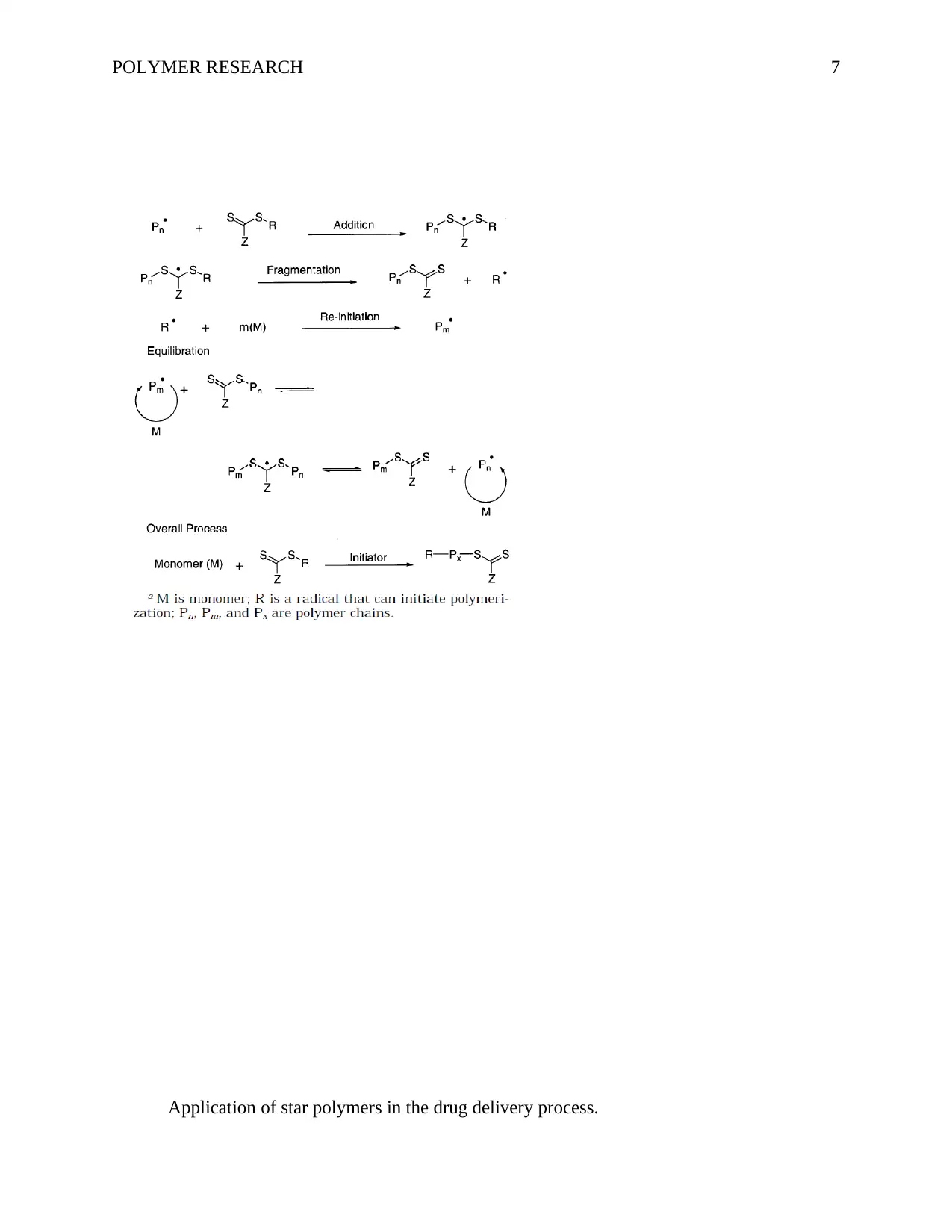
POLYMER RESEARCH 7
Application of star polymers in the drug delivery process.
Application of star polymers in the drug delivery process.
Paraphrase This Document
Need a fresh take? Get an instant paraphrase of this document with our AI Paraphraser
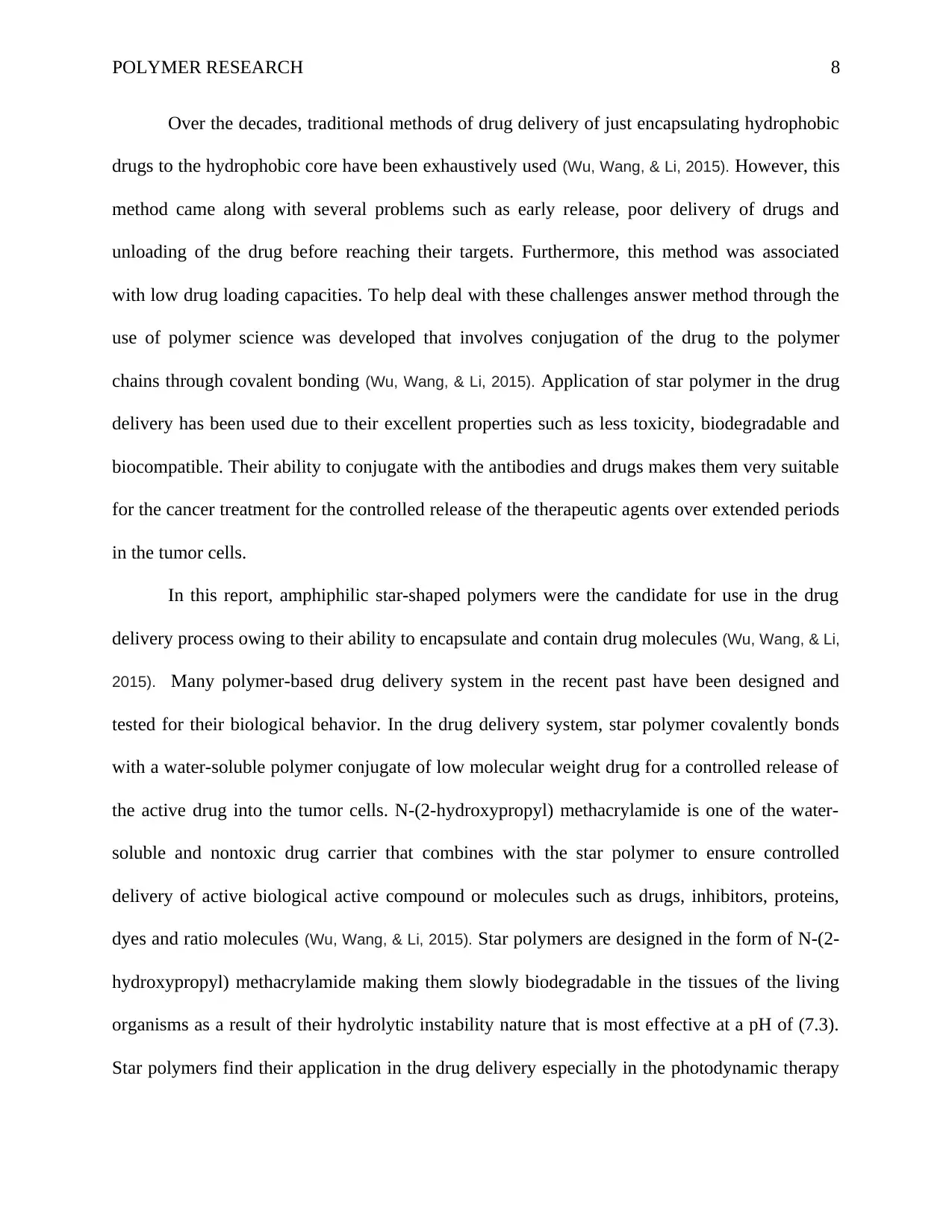
POLYMER RESEARCH 8
Over the decades, traditional methods of drug delivery of just encapsulating hydrophobic
drugs to the hydrophobic core have been exhaustively used (Wu, Wang, & Li, 2015). However, this
method came along with several problems such as early release, poor delivery of drugs and
unloading of the drug before reaching their targets. Furthermore, this method was associated
with low drug loading capacities. To help deal with these challenges answer method through the
use of polymer science was developed that involves conjugation of the drug to the polymer
chains through covalent bonding (Wu, Wang, & Li, 2015). Application of star polymer in the drug
delivery has been used due to their excellent properties such as less toxicity, biodegradable and
biocompatible. Their ability to conjugate with the antibodies and drugs makes them very suitable
for the cancer treatment for the controlled release of the therapeutic agents over extended periods
in the tumor cells.
In this report, amphiphilic star-shaped polymers were the candidate for use in the drug
delivery process owing to their ability to encapsulate and contain drug molecules (Wu, Wang, & Li,
2015). Many polymer-based drug delivery system in the recent past have been designed and
tested for their biological behavior. In the drug delivery system, star polymer covalently bonds
with a water-soluble polymer conjugate of low molecular weight drug for a controlled release of
the active drug into the tumor cells. N-(2-hydroxypropyl) methacrylamide is one of the water-
soluble and nontoxic drug carrier that combines with the star polymer to ensure controlled
delivery of active biological active compound or molecules such as drugs, inhibitors, proteins,
dyes and ratio molecules (Wu, Wang, & Li, 2015). Star polymers are designed in the form of N-(2-
hydroxypropyl) methacrylamide making them slowly biodegradable in the tissues of the living
organisms as a result of their hydrolytic instability nature that is most effective at a pH of (7.3).
Star polymers find their application in the drug delivery especially in the photodynamic therapy
Over the decades, traditional methods of drug delivery of just encapsulating hydrophobic
drugs to the hydrophobic core have been exhaustively used (Wu, Wang, & Li, 2015). However, this
method came along with several problems such as early release, poor delivery of drugs and
unloading of the drug before reaching their targets. Furthermore, this method was associated
with low drug loading capacities. To help deal with these challenges answer method through the
use of polymer science was developed that involves conjugation of the drug to the polymer
chains through covalent bonding (Wu, Wang, & Li, 2015). Application of star polymer in the drug
delivery has been used due to their excellent properties such as less toxicity, biodegradable and
biocompatible. Their ability to conjugate with the antibodies and drugs makes them very suitable
for the cancer treatment for the controlled release of the therapeutic agents over extended periods
in the tumor cells.
In this report, amphiphilic star-shaped polymers were the candidate for use in the drug
delivery process owing to their ability to encapsulate and contain drug molecules (Wu, Wang, & Li,
2015). Many polymer-based drug delivery system in the recent past have been designed and
tested for their biological behavior. In the drug delivery system, star polymer covalently bonds
with a water-soluble polymer conjugate of low molecular weight drug for a controlled release of
the active drug into the tumor cells. N-(2-hydroxypropyl) methacrylamide is one of the water-
soluble and nontoxic drug carrier that combines with the star polymer to ensure controlled
delivery of active biological active compound or molecules such as drugs, inhibitors, proteins,
dyes and ratio molecules (Wu, Wang, & Li, 2015). Star polymers are designed in the form of N-(2-
hydroxypropyl) methacrylamide making them slowly biodegradable in the tissues of the living
organisms as a result of their hydrolytic instability nature that is most effective at a pH of (7.3).
Star polymers find their application in the drug delivery especially in the photodynamic therapy
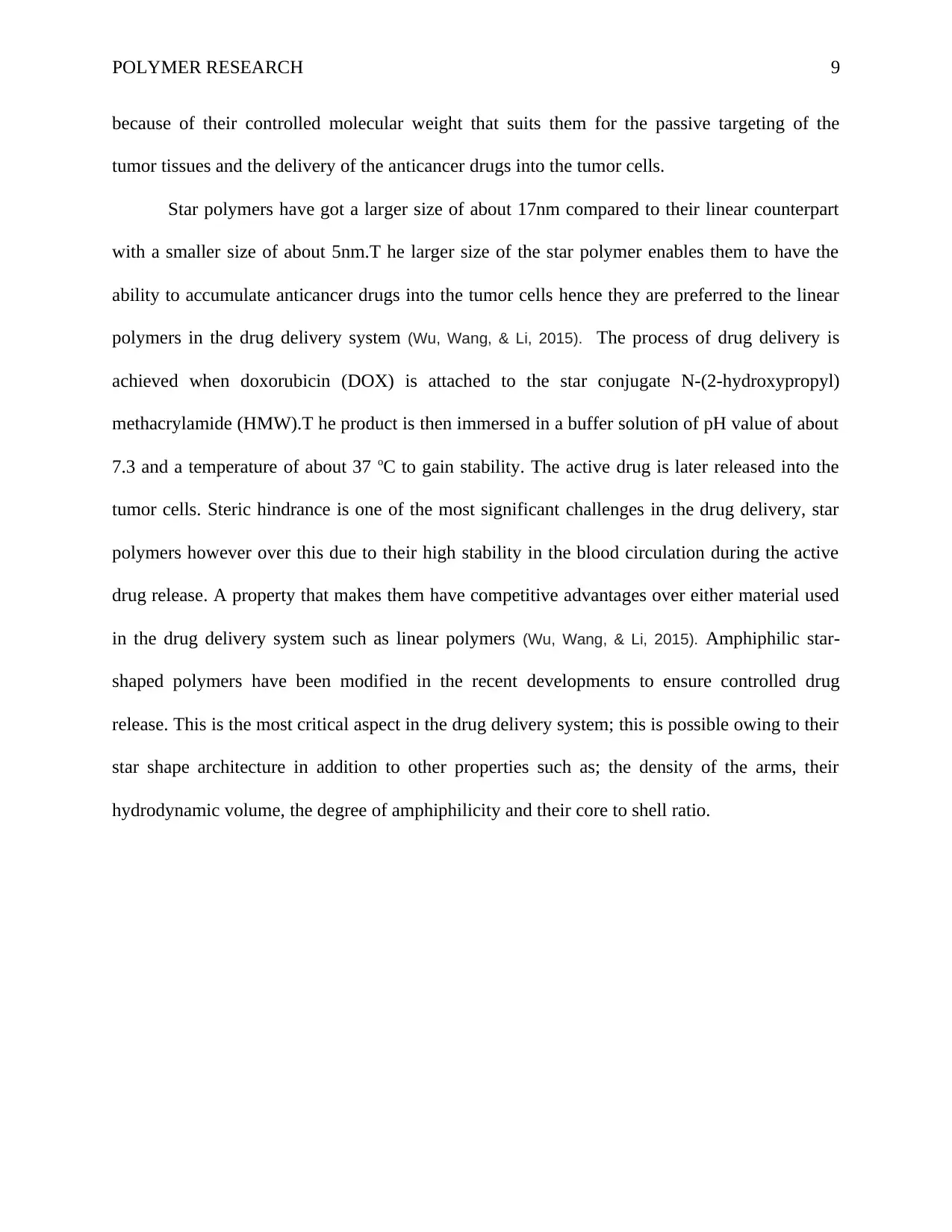
POLYMER RESEARCH 9
because of their controlled molecular weight that suits them for the passive targeting of the
tumor tissues and the delivery of the anticancer drugs into the tumor cells.
Star polymers have got a larger size of about 17nm compared to their linear counterpart
with a smaller size of about 5nm.T he larger size of the star polymer enables them to have the
ability to accumulate anticancer drugs into the tumor cells hence they are preferred to the linear
polymers in the drug delivery system (Wu, Wang, & Li, 2015). The process of drug delivery is
achieved when doxorubicin (DOX) is attached to the star conjugate N-(2-hydroxypropyl)
methacrylamide (HMW).T he product is then immersed in a buffer solution of pH value of about
7.3 and a temperature of about 37 oC to gain stability. The active drug is later released into the
tumor cells. Steric hindrance is one of the most significant challenges in the drug delivery, star
polymers however over this due to their high stability in the blood circulation during the active
drug release. A property that makes them have competitive advantages over either material used
in the drug delivery system such as linear polymers (Wu, Wang, & Li, 2015). Amphiphilic star-
shaped polymers have been modified in the recent developments to ensure controlled drug
release. This is the most critical aspect in the drug delivery system; this is possible owing to their
star shape architecture in addition to other properties such as; the density of the arms, their
hydrodynamic volume, the degree of amphiphilicity and their core to shell ratio.
because of their controlled molecular weight that suits them for the passive targeting of the
tumor tissues and the delivery of the anticancer drugs into the tumor cells.
Star polymers have got a larger size of about 17nm compared to their linear counterpart
with a smaller size of about 5nm.T he larger size of the star polymer enables them to have the
ability to accumulate anticancer drugs into the tumor cells hence they are preferred to the linear
polymers in the drug delivery system (Wu, Wang, & Li, 2015). The process of drug delivery is
achieved when doxorubicin (DOX) is attached to the star conjugate N-(2-hydroxypropyl)
methacrylamide (HMW).T he product is then immersed in a buffer solution of pH value of about
7.3 and a temperature of about 37 oC to gain stability. The active drug is later released into the
tumor cells. Steric hindrance is one of the most significant challenges in the drug delivery, star
polymers however over this due to their high stability in the blood circulation during the active
drug release. A property that makes them have competitive advantages over either material used
in the drug delivery system such as linear polymers (Wu, Wang, & Li, 2015). Amphiphilic star-
shaped polymers have been modified in the recent developments to ensure controlled drug
release. This is the most critical aspect in the drug delivery system; this is possible owing to their
star shape architecture in addition to other properties such as; the density of the arms, their
hydrodynamic volume, the degree of amphiphilicity and their core to shell ratio.
⊘ This is a preview!⊘
Do you want full access?
Subscribe today to unlock all pages.

Trusted by 1+ million students worldwide
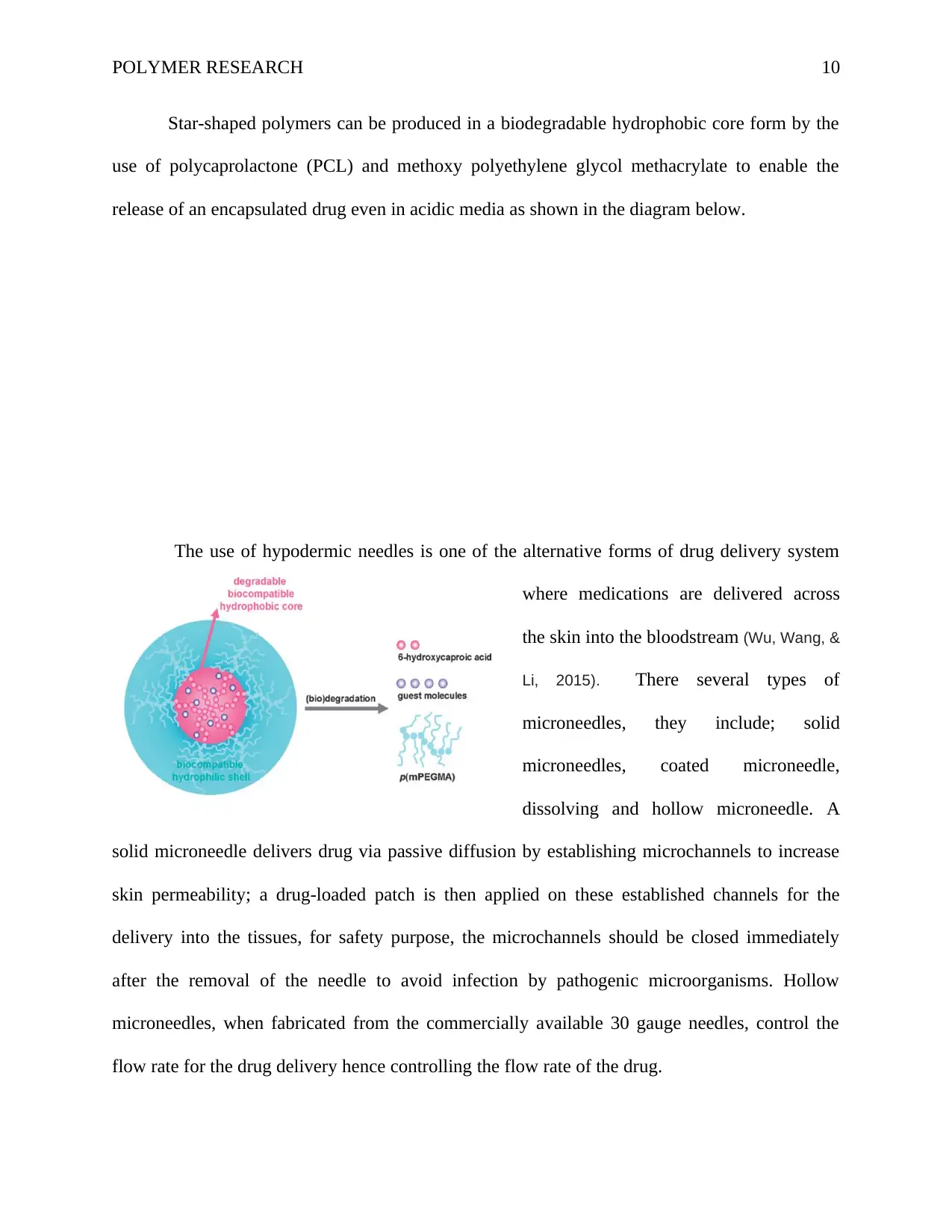
POLYMER RESEARCH 10
Star-shaped polymers can be produced in a biodegradable hydrophobic core form by the
use of polycaprolactone (PCL) and methoxy polyethylene glycol methacrylate to enable the
release of an encapsulated drug even in acidic media as shown in the diagram below.
The use of hypodermic needles is one of the alternative forms of drug delivery system
where medications are delivered across
the skin into the bloodstream (Wu, Wang, &
Li, 2015). There several types of
microneedles, they include; solid
microneedles, coated microneedle,
dissolving and hollow microneedle. A
solid microneedle delivers drug via passive diffusion by establishing microchannels to increase
skin permeability; a drug-loaded patch is then applied on these established channels for the
delivery into the tissues, for safety purpose, the microchannels should be closed immediately
after the removal of the needle to avoid infection by pathogenic microorganisms. Hollow
microneedles, when fabricated from the commercially available 30 gauge needles, control the
flow rate for the drug delivery hence controlling the flow rate of the drug.
Star-shaped polymers can be produced in a biodegradable hydrophobic core form by the
use of polycaprolactone (PCL) and methoxy polyethylene glycol methacrylate to enable the
release of an encapsulated drug even in acidic media as shown in the diagram below.
The use of hypodermic needles is one of the alternative forms of drug delivery system
where medications are delivered across
the skin into the bloodstream (Wu, Wang, &
Li, 2015). There several types of
microneedles, they include; solid
microneedles, coated microneedle,
dissolving and hollow microneedle. A
solid microneedle delivers drug via passive diffusion by establishing microchannels to increase
skin permeability; a drug-loaded patch is then applied on these established channels for the
delivery into the tissues, for safety purpose, the microchannels should be closed immediately
after the removal of the needle to avoid infection by pathogenic microorganisms. Hollow
microneedles, when fabricated from the commercially available 30 gauge needles, control the
flow rate for the drug delivery hence controlling the flow rate of the drug.
Paraphrase This Document
Need a fresh take? Get an instant paraphrase of this document with our AI Paraphraser
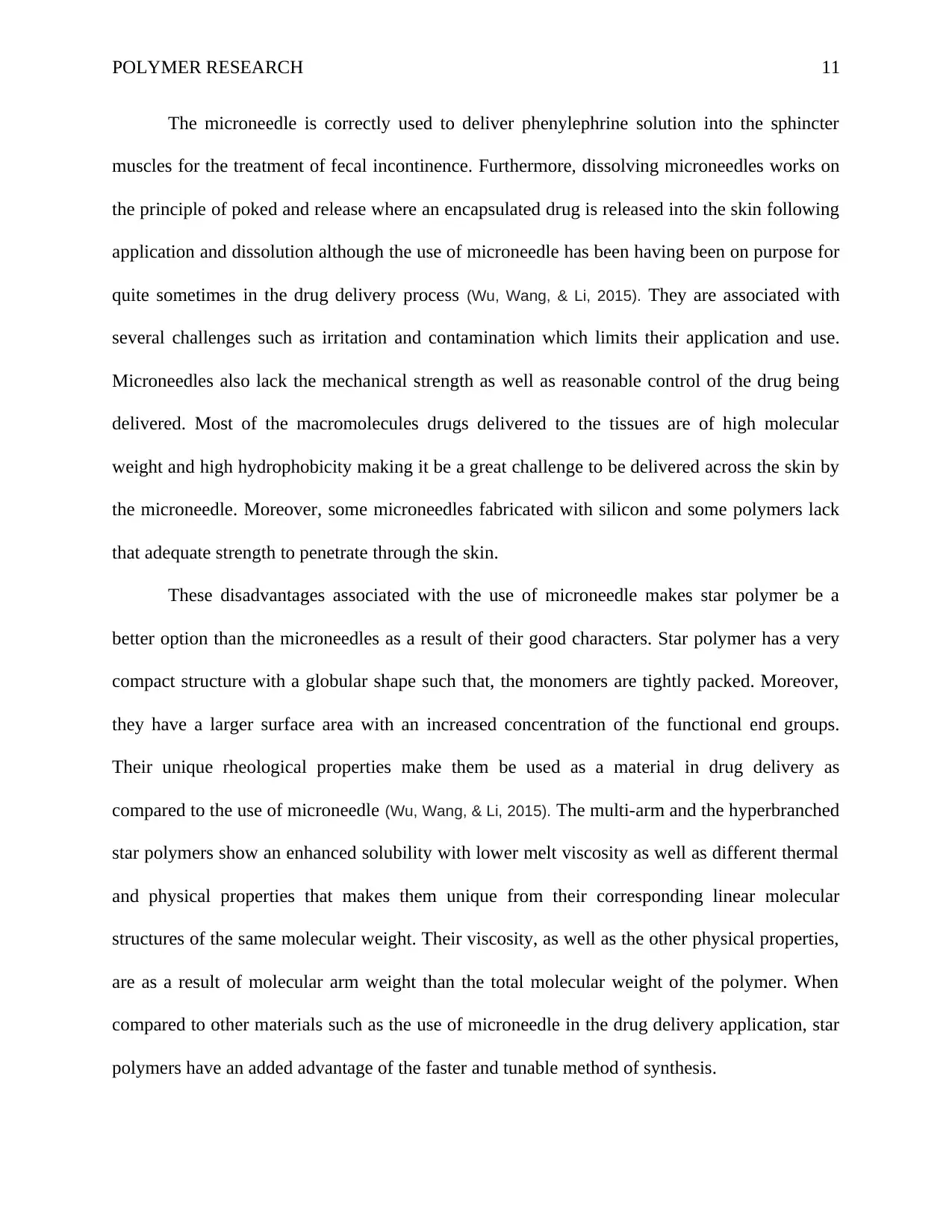
POLYMER RESEARCH 11
The microneedle is correctly used to deliver phenylephrine solution into the sphincter
muscles for the treatment of fecal incontinence. Furthermore, dissolving microneedles works on
the principle of poked and release where an encapsulated drug is released into the skin following
application and dissolution although the use of microneedle has been having been on purpose for
quite sometimes in the drug delivery process (Wu, Wang, & Li, 2015). They are associated with
several challenges such as irritation and contamination which limits their application and use.
Microneedles also lack the mechanical strength as well as reasonable control of the drug being
delivered. Most of the macromolecules drugs delivered to the tissues are of high molecular
weight and high hydrophobicity making it be a great challenge to be delivered across the skin by
the microneedle. Moreover, some microneedles fabricated with silicon and some polymers lack
that adequate strength to penetrate through the skin.
These disadvantages associated with the use of microneedle makes star polymer be a
better option than the microneedles as a result of their good characters. Star polymer has a very
compact structure with a globular shape such that, the monomers are tightly packed. Moreover,
they have a larger surface area with an increased concentration of the functional end groups.
Their unique rheological properties make them be used as a material in drug delivery as
compared to the use of microneedle (Wu, Wang, & Li, 2015). The multi-arm and the hyperbranched
star polymers show an enhanced solubility with lower melt viscosity as well as different thermal
and physical properties that makes them unique from their corresponding linear molecular
structures of the same molecular weight. Their viscosity, as well as the other physical properties,
are as a result of molecular arm weight than the total molecular weight of the polymer. When
compared to other materials such as the use of microneedle in the drug delivery application, star
polymers have an added advantage of the faster and tunable method of synthesis.
The microneedle is correctly used to deliver phenylephrine solution into the sphincter
muscles for the treatment of fecal incontinence. Furthermore, dissolving microneedles works on
the principle of poked and release where an encapsulated drug is released into the skin following
application and dissolution although the use of microneedle has been having been on purpose for
quite sometimes in the drug delivery process (Wu, Wang, & Li, 2015). They are associated with
several challenges such as irritation and contamination which limits their application and use.
Microneedles also lack the mechanical strength as well as reasonable control of the drug being
delivered. Most of the macromolecules drugs delivered to the tissues are of high molecular
weight and high hydrophobicity making it be a great challenge to be delivered across the skin by
the microneedle. Moreover, some microneedles fabricated with silicon and some polymers lack
that adequate strength to penetrate through the skin.
These disadvantages associated with the use of microneedle makes star polymer be a
better option than the microneedles as a result of their good characters. Star polymer has a very
compact structure with a globular shape such that, the monomers are tightly packed. Moreover,
they have a larger surface area with an increased concentration of the functional end groups.
Their unique rheological properties make them be used as a material in drug delivery as
compared to the use of microneedle (Wu, Wang, & Li, 2015). The multi-arm and the hyperbranched
star polymers show an enhanced solubility with lower melt viscosity as well as different thermal
and physical properties that makes them unique from their corresponding linear molecular
structures of the same molecular weight. Their viscosity, as well as the other physical properties,
are as a result of molecular arm weight than the total molecular weight of the polymer. When
compared to other materials such as the use of microneedle in the drug delivery application, star
polymers have an added advantage of the faster and tunable method of synthesis.
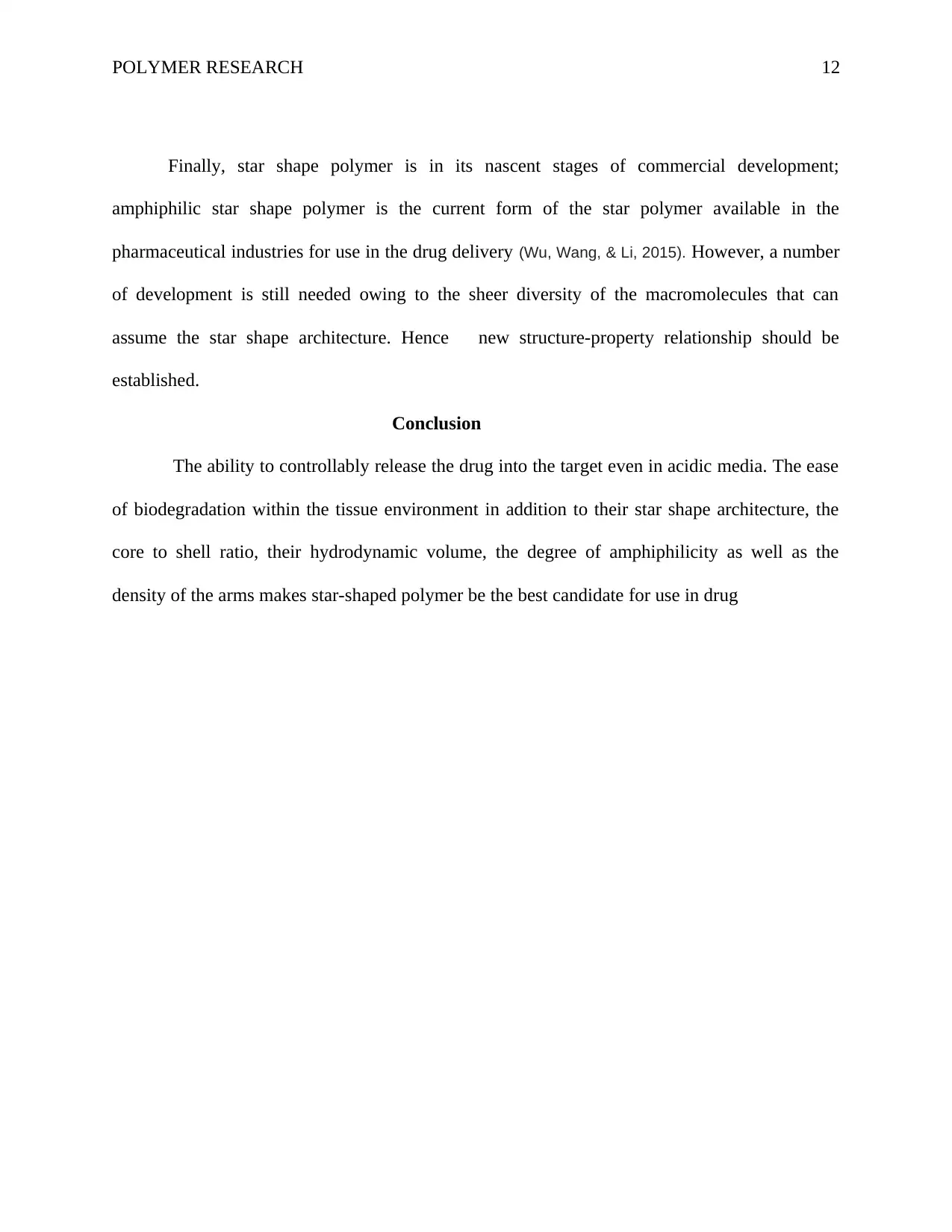
POLYMER RESEARCH 12
Finally, star shape polymer is in its nascent stages of commercial development;
amphiphilic star shape polymer is the current form of the star polymer available in the
pharmaceutical industries for use in the drug delivery (Wu, Wang, & Li, 2015). However, a number
of development is still needed owing to the sheer diversity of the macromolecules that can
assume the star shape architecture. Hence new structure-property relationship should be
established.
Conclusion
The ability to controllably release the drug into the target even in acidic media. The ease
of biodegradation within the tissue environment in addition to their star shape architecture, the
core to shell ratio, their hydrodynamic volume, the degree of amphiphilicity as well as the
density of the arms makes star-shaped polymer be the best candidate for use in drug
Finally, star shape polymer is in its nascent stages of commercial development;
amphiphilic star shape polymer is the current form of the star polymer available in the
pharmaceutical industries for use in the drug delivery (Wu, Wang, & Li, 2015). However, a number
of development is still needed owing to the sheer diversity of the macromolecules that can
assume the star shape architecture. Hence new structure-property relationship should be
established.
Conclusion
The ability to controllably release the drug into the target even in acidic media. The ease
of biodegradation within the tissue environment in addition to their star shape architecture, the
core to shell ratio, their hydrodynamic volume, the degree of amphiphilicity as well as the
density of the arms makes star-shaped polymer be the best candidate for use in drug
⊘ This is a preview!⊘
Do you want full access?
Subscribe today to unlock all pages.

Trusted by 1+ million students worldwide
1 out of 14
Your All-in-One AI-Powered Toolkit for Academic Success.
+13062052269
info@desklib.com
Available 24*7 on WhatsApp / Email
![[object Object]](/_next/static/media/star-bottom.7253800d.svg)
Unlock your academic potential
Copyright © 2020–2025 A2Z Services. All Rights Reserved. Developed and managed by ZUCOL.

